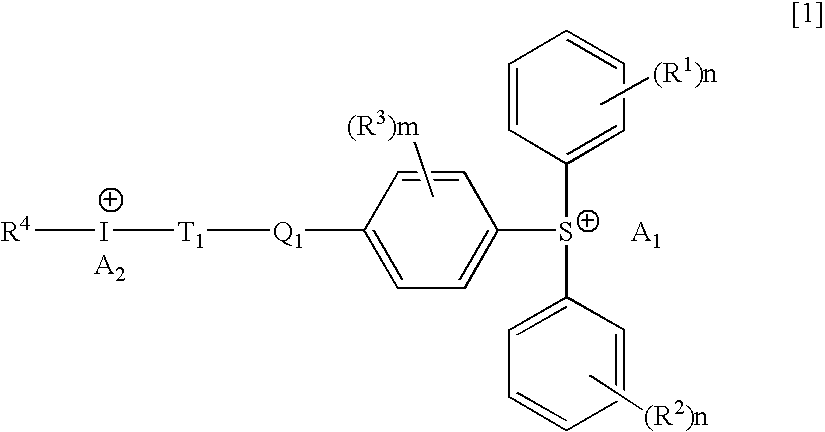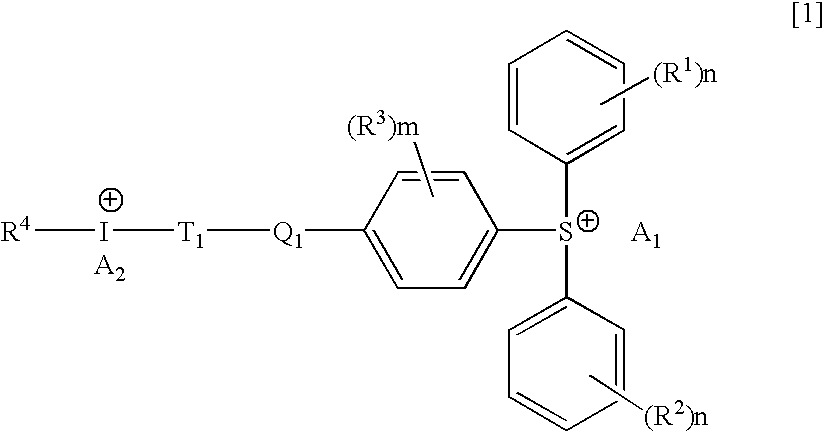Hybrid type onium salt
a technology of onium salt and hybridization, which is applied in the field of hybridization onium salt, can solve the problems of low acid generation efficiency, difficult to form a polymer with high hardness, and low solubility of sulfonium salt and iodonium sal
- Summary
- Abstract
- Description
- Claims
- Application Information
AI Technical Summary
Benefits of technology
Problems solved by technology
Method used
Image
Examples
example
Example 1
Synthesis of 4-[4-(diphenylsulfonio)phenylthio]phenyl-phenyl iodonium bis(hexafluorophosphate), (corresponding to the compound shown by the general formula [4])
(1) Synthesis of diphenyl-4-phenylthiophenylsulfonium trifluoromethanesulfonate
[0186]In 400 ml of dichloromethane were dissolved 40.4 g (0.2 mol) of diphenylsulfoxide and 37.2 g (0.2 mol) of diphenylsulfide, and 50.4 g (0.24 mol) of trifluoroacetic anhydride was added thereto at 0° C. Then 30.0 g (0.2 mol) of trifluoromethanesulfonic acid was added dropwise to the resultant at 0 to 5° C., followed by gradually warming to room temperature and reacting for 2 hours with stirring. After completion of the reaction, the reaction solution was washed with 400 ml of water five times and concentrated under reduced pressure, followed by purifying the resulting crude product by a column chromatography to obtain 33.2 g (Yield: 32%) of diphenyl-4-phenylthiophenylsulfonium trifluoromethanesulfonate as a yellow oily substance.
[0187]...
example 2
Synthesis of bis{4-[4-(diphenylsulfonio)phenylthio]phenyl}iodonium tris(hexafluorophosphate) (corresponding to the compound shown by the general formula [11])
[0190]In 20 ml of acetic anhydride was dissolved 5.2 g (0.01 mol) of diphenyl-4-phenylthiophenylsulfonium trifluoromethanesulfonate obtained in Example 1, and 1.07 g (0.005 mol) of potassium iodate was added thereto at 0° C. Then a mixed acid consisted of 2.5 g (0.025 mol) of concentrated sulfuric acid and 3.0 g of acetic anhydride was added dropwise thereto at 0 to 3° C. for 1 hour, followed by gradually warming to room temperature and reacting for 9 hours with stirring. After completion of the reaction, the reaction solution was poured into 200 ml of ice water and 5.55 g (0.03 mol) of potassium hexafluorophosphate was added thereto, followed by adding 200 ml of dichloromethane thereto and stirring for 2 hours at room temperature. Then, the solution was fractionated, and 200 ml of water was poured into the resulting dichlorome...
example 3
Synthesis of bis{4-[4-(diphenylsulfonio)phenoxy]phenyl}iodonium tris(hexafluorophosphate) (corresponding to the compound shown by the general formula [12])
(1) Synthesis of diphenyl-4-phenoxyphenylsulfonium trifluoromethanesulfonate
[0192]In 100 ml of dichloromethane were dissolved 10.1 g (0.05 mol) of diphenylsulfoxide and 8.51 g (0.05 mol) of diphenyl ether, and 12.6 g (0.06 mol) of trifluoroacetic anhydride was added thereto at 0° C. Then 7.5 g (0.05 mol) of trifluoromethanesulfonic acid was added dropwise thereto at 0 to 5° C., followed by gradually warming to room temperature and reacting for 2 hours with stirring. After completion of the reaction, the reaction solution was washed with 100 ml of water five times and concentrated under reduced pressure, followed by purifying the resulting crude product by a column chromatography to obtain 9.59 g (Yield: 38%) of diphenyl-4-phenoxyphenylsulfonium trifluoromethanesulfonate as a yellow oily substance.
[0193]1HNMR (CDCl3) δ ppm: 7.09 (2...
PUM
| Property | Measurement | Unit |
|---|---|---|
| temperature | aaaaa | aaaaa |
| temperature | aaaaa | aaaaa |
| temperature | aaaaa | aaaaa |
Abstract
Description
Claims
Application Information
 Login to View More
Login to View More - R&D
- Intellectual Property
- Life Sciences
- Materials
- Tech Scout
- Unparalleled Data Quality
- Higher Quality Content
- 60% Fewer Hallucinations
Browse by: Latest US Patents, China's latest patents, Technical Efficacy Thesaurus, Application Domain, Technology Topic, Popular Technical Reports.
© 2025 PatSnap. All rights reserved.Legal|Privacy policy|Modern Slavery Act Transparency Statement|Sitemap|About US| Contact US: help@patsnap.com



